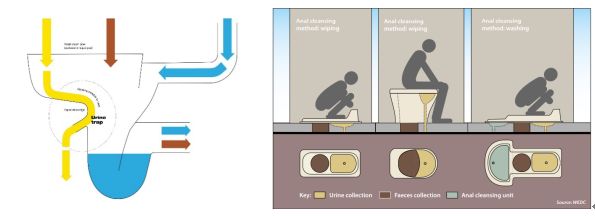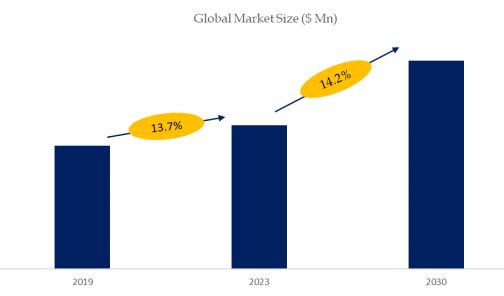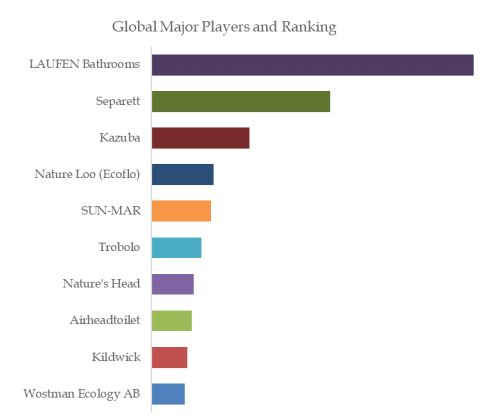The global Urine Diverting Toilets market size is projected to grow from USD 31.36 million in 2024 to USD 43.87 million by 2030
Published Date: Thursday,25 Apr,2024





Urine Diverting Toilets Market Summary
A urine diverting toilet separates urine and solid waste. The toilet is equipped with a fan that draws out moisture and air which makes it completely odorless in the space where the toilet is located. A urine diverting toilet works in all environments, as no drain, heated space or water is required. Thanks to the urine separation, both the smell and the volume of the waste that must be disposed of is reduced. The urine is discharged to a collection vessel or infiltration, while the solid waste ends up in a compostable biobag made of corn starch which can then be composted.
According to the new market research report "Global Urine Diverting Toilets Market Report 2024-2030", published by GlobalInfoResearch, the global Urine Diverting Toilets market size is projected to grow from USD 31.36 million in 2024 to USD 43.87 million by 2030, at a CAGR of 5.8% during the forecast period.
- Product Picture of Urine Diverting Toilets

Source: GlobalInfoResearch, “Global Urine Diverting Toilets Market 2024 by Manufacturers, Regions, Type and Application, Forecast to 2030”
- Global Urine Diverting Toilets MarketSize(US$ Million), 2019-2030

Source: GlobalInfoResearch, “Global Urine Diverting Toilets Market 2024 by Manufacturers, Regions, Type and Application, Forecast to 2030”(published in 2024). If you need the latest data, plaese contact GlobalInfoResearch.
- Global Urine Diverting Toilets Top11Players Ranking and Market Share (Ranking is based on the revenue of 2023, continually updated)

Above data is based on report from GlobalInfoResearch: Global Urine Diverting Toilets Market Report 2023-2029 (published in 2024). If you need the latest data, plaese contact GlobalInfoResearch.
This report profiles key players of Urine Diverting Toilets such as LAUFEN Bathrooms, Separett, Kazuba, Nature Loo (Ecoflo), SUN-MAR.
In 2023, the global top five Urine Diverting Toilets players account for 39.19% of market share in terms of revenue. Above figure shows the key players ranked by revenue in Urine Diverting Toilets.
Market Drivers:
The need for improved hygiene and circular economy
Since the International Year of Sanitation in 2008, more and more users, stakeholders and decision makers have become aware of the worldwide sanitation crisis with more than 2.5 billion people having no or insufficient access to basic sanitation. The contamination of the environment with infectious faecal material causes health hazards which lead to the death of thousands of people, especially young children, on a daily basis, which could be prevented.
In the recent decade, urine-diverting dry toilets (UDDTs) have been recognised as a viable sanitation technology that is being accepted by users, from both a cost and user comfort perspective. Moreover the technology provides possibilities to develop value chains for recycling of excreta for agricultural purposes or to allow safe disposal. UDDT collects human waste and reuses it as fertilizer, which is beneficial to the ecological cycle.
Disadvantages of Pit Latrines
According to the Joint Monitoring Program (JMP), approximately 2.5 billion people do not have access to improved sanitation facilities, and 1.1 billion of them still practice open defecation. There is also a general lack of knowledge and practice of key health behaviors. Therefore, ingestion and fecal transmission of fecal pathogens from contaminated food and water resources are major causes of illness and preventable death. In 2010, the World Health Organization (WHO) reported that diarrheal disease affects children more globally than HIV/AIDS, tuberculosis and malaria combined. Pit latrines are common in developing and transition countries because they are relatively cheap and simple to operate without using water. However, pit latrines can spread fecal contamination into water resources, especially in urban areas and in flood-prone areas and areas with high water tables.
Additionally, where emptying is not feasible, pit latrines may incur high life cycle costs from removing fecal sludge or digging new pits. Limited water supplies and high wastewater infrastructure costs make sewer-based waste management increasingly impractical in many areas. Water-based sanitation systems dilute excreta and generate large wastewater streams, requiring the construction of technically complex and expensive sewers and treatment facilities. An estimated 90% of wastewater in developing countries is discharged directly into water bodies without treatment, clearly demonstrating that sewer-based sanitation is not a viable solution for many parts of the world.
Additionally, pharmaceutical residues in treated wastewater may have negative effects on human health. People's expectations and attitudes towards sanitation vary widely and are influenced by social norms and personal preferences. While improving hygiene standards, reducing the impact of pollutants and minimizing water consumption may be the goals of hygiene practitioners, toilet users often strive to improve current hygiene conditions in terms of odor, insect infestation, privacy, comfort and "prestige".
Advantages of UDDT
UDDTs provide a number of benefits in a range of rural and urban environments being: (1) waterless operation; (2) no odour when correctly used and maintained; (3) treated faecal matter is dry, odourless and less offensive ; (4) does not attract flies or other vectors ; (5) treated faecal matter is partially sanitised and safer to handle; (6) aboveground design or use of containers in belowground vaults makes emptying simple; (7) minimal risk of contamination of ground and surface water resources; (8) possibility for aboveground design facilitates construction in challenging environments, such as rocky or unstable soils and high water table; and (9) possibility for construction in close proximity to or inside of the home which adds to security and convenience for users. UDDTs also have a well-documented record of resilience during flood events. The sealed, aboveground vaults can be built above the established flood line and also returned to operation quickly when affected.
Reduce Pollution
Pollution is a worldwide problem. The world's wastewater systems cannot keep up with demand, resulting in untreated sewage being dumped into rivers and oceans. This has had a knock-on effect on the wildlife that relies on these water sources, thereby jeopardizing water security for humans. Urine-diversion composting toilets are a great way to protect waterways from pollution.
Save Energy
Traditional toilets use a lot of energy to move water and then flush it back down the drain. Ultimately more energy is used to pump and treat wastewater. Because the UDDT collects human urine on a separate front end and does not mix with solid waste, the UDDT requires only a small amount of water to flush the toilet. Less flushing means UDDT uses less water, which means less energy consumption.
Restraint:
Pathogen Infection Risk
Including inactivation of all helminth eggs, cannot be guaranteed under ordinary circumstances with any type of UDDT. While reduced pathogen content makes handling of faeces safer, it is paramount that safety protocols are met when emptying the faeces vaults due to the remaining health risks associated with the residual pathogen load. For agricultural applications and, in some cases, disposal, it is recommended to apply a post-treatment regimen to further reduce the faecal pathogen load and stabilise the material.
High Capital Cost/Operation and Maintenance Cost
The wide range of designs and construction materials available on the market can provide a solution for almost any budget. Some ceramic UD squat toilets are mass-produced in India and sell for less than €10. But with the overall cost of a UDDT ranging from €100-600, it is generally considered that UDDTs are too expensive (compared to pit toilets) and even a toilet that only costs €50 is often out of reach for the poorest people.
Challenges:
UDDT has low market acceptance
The UDDT is a dry excreta management system that since the late-1990s is seen as a viable alternative to pit latrines and flush toilets. However, significant barriers to more universal acceptance of this technology remain. To date, a general lack of awareness, a limited supply of prefabricated UDDT components and a low interest in financing sanitation services, have all acted as impediments to the construction of UDDTs.
Labor costs: Use and maintenance require dedicated training
Many sanitation projects, both conventional and alternative systems, have been implemented through subsidised topdown programmes and ultimately resulted in high construction costs, a lack of ownership, neglect of facilities and poor scalability.
The UDDT is a relatively new concept .The difficulty of adjusting one’s toilet habits to a UDDT should not be underestimated, and may be best approached with intuitive toilet designs and comprehensive user training programmes. Many organisations have also hung illustrated instructional posters in the toilet’s interior for user guidance. Accidental misuse is inevitable when users are not aware of or accustomed to proper operational procedures, which can render the UDDT temporarily inoperable. The foremost challenge with UDDTs is to make their use and maintenance simpler and thus more acceptable. The preferences of most users generally lie with convenient, rather than sustainable, sanitation systems. Additionally, users may have a strong aversion to managing excreta. Automated systems to mechanically enclose the faeces and to add cover material after each use might be future technological advances. It is also critical that service providers begin to include ‘dry sanitation maintenance’ options in their list of available services. UDDT specific services may include the supply of cover material, the removal and sanitisation of excreta, and the sale of fertilisers from post-treatment procedures.
Some markets are more difficult to promote
Urine diversion dry toilets (UDDT) have been implemented in areas with poor sanitation conditions. However, some developing countries have reported that UDDT lacks supporting infrastructure, has high capital costs, and has ineffective promotional communication strategies. Product selling points are inconsistent with the desires and interests of potential adopters.
Contact Us:
If you have any questions or have further requirements about this report, please contact us.
GlobaI Info Research Co.,Ltd
Website: https://www.globalinforesearch.com
TEL: HK: 00852-58030175
TEL: US: 001-347 966 1888
E-mail: report@globalinforesearch.com
About Global Info Research:
Global Info Research is a report publisher, a customer, interest-based suppliers. Is in the best interests of our clients, they determine our every move. At the same time, we have great respect for the views of customers. With the improvement of the quality of our research, we develop custom interdisciplinary and comprehensive solution. For further development, we will do better and better. GlobalInfoResearch will with excellent professional knowledge and experience to carry out all aspects of our business. At the same time, we will thoroughly look for information, to give a more comprehensive development.
Global Info Research has more than 30000 global well-known customers, covering more than 30 industries, research regions cover China,Japan,Korea,US,EU,Asia,Middle East and Africa,South America,Australia,etc.
More information:
Global Urine Diverting Toilets Market 2024 by Manufacturers, Regions, Type and Application, Forecast to 2030
Previous News:
The global Ultra-thin Electronic Glass market size is projected to reach USD 3.8 billion by 2029
Next News:
The global Vacuum Dry Pumps market size is projected to reach USD 6163 million by 2029
Global Info Research promotes respect for and protection of intellectual property. If you are aware of any copyright or other problems with any article on this site, please contact us and we will deal with you promptly. Contact details: report@globalinforesearch.com
Popular Product Keywords
- We Provide Professional, Accurate Market Analysis to Help You Stay Ahead of Your Competition.Speak to our analyst >>
Our Clients
What We Can Provide?
With better results and higher quality products,Our professional reports can achieve four things:

Insight into the industry market information

Analyze market development needs

Prospects for future development

Develop industry investment strategy
- Digging deeper into global industry information and providing market strategies.Contact Us >>
Popular Product Keywords
- We Provide Professional, Accurate Market Analysis to Help You Stay Ahead of Your Competition.Speak to our analyst >>
Our Clients
What We Can Provide?
With better results and higher quality products,Our professional reports can achieve four things:

Insight into the industry market information

Analyze market development needs

Prospects for future development

Develop industry investment strategy
- Digging deeper into global industry information and providing market strategies.Contact Us >>